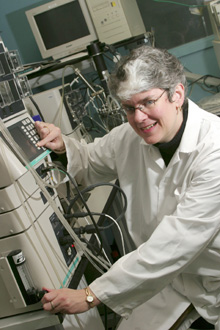Carbon dioxide transformed from the air

Catherine Mulligan in her lab.
Photo by Andrew dobrowolskyj
One of the Petro-Canada awards handed out this year to innovative Concordia researchers goes to someone who received the same honour two years ago.
Environmental engineer Catherine Mulligan, the winner of the 2004-05 Petro-Canada Young Innovator Awards Program, will use the $10,000 prize to investigate a novel way of reducing carbon dioxide (CO2) in the environment.
Mulligan, an associate professor of Building, Civil and Environmental
Engineering, noted that carbon dioxide emissions from fossil fuel sources, including large power plants and petroleum refineries, account for 80 per cent of the greenhouse gas effect that threatens the Earth’s atmosphere.
“Levels of carbon dioxide have increased recently by 0.4 per cent per year, and have increased by 30 per cent in the last 150 years. It is thus absolutely necessary to reduce these emissions,” she said. One way of doing so is to capture the carbon dioxide from the air and convert it to another product.
Mulligan recalled that while employed in industry, she did research on a method that uses anaerobic bacteria to convert carbon products in wastewater into various products. In one step in this process, carbon dioxide combines with hydrogen from acetic acid to form methane (CH4).
Last year she supervised a lab experiment to see whether a similar process would work with carbon dioxide from the air. This preliminary research demonstrated that 80 to 90 per cent of the carbon dioxide was converted to methane.
Mulligan proposes to continue this work with the Petro-Canada award. This time the goal will be to improve the process and make it as cost-effective as possible, so that it can be used on an industrial scale.
“The most sustainable method would be to combine wastewater treatment with carbon dioxide removal from the air emissions in a combined system.
Petroleum industries typically produce carbon dioxide and wastewater effluents.” Not only could this process greatly reduce the concentration of carbon dioxide in the air, but the methane that is produced could be used as an energy source.
“You can use methane to generate electricity, or you can compress it and burn it for heating purposes, similar to natural gas,” Mulligan explained.
The Petro-Canada Young Innovator Awards Program (PCYIAP) was developed to recognize and support outstanding young faculty researchers.
It is based on several factors, including the overall research promise of the individual researcher, the degree of innovation of the work, the quality of the proposal, and its potential impact on society. Preference may also be given to faculty who are conducting research in areas directly related to Petro-Canada’s business.
Mulligan also won the award in 2002, the year the program was introduced, for a project on using biological dispersing agents to clean up oil spills.
Mulligan holds Concordia’s research chair in environmental engineering. She studied chemical engineering at McGill, did research at SNC Research, then got a PhD in geo-environmental engineering at McGill. She came to Concordia in 1999 and helped set up the university’s environmental engineering lab. The graduate program has been growing rapidly ever since.
Mulligan now supervises 15 graduate students, about half of them women, and hopes that Concordia will eventually also offer an undergraduate program in this increasingly important field.